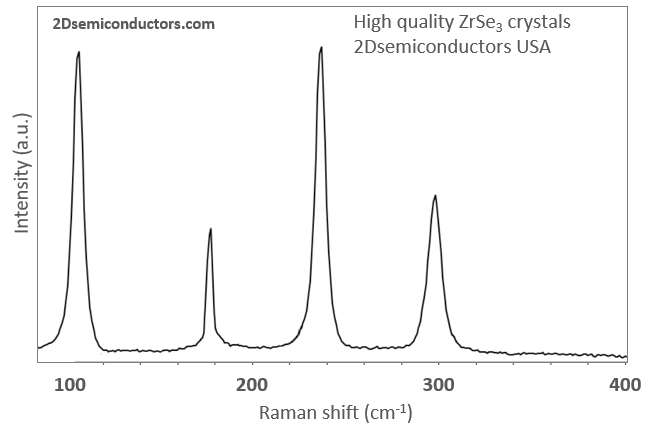Description
Zirconium triselenide (ZrSe3) exhibits coexistence of a charge density waves (CDW) at around 60 K and superconducting response at ~2K. It belongs to the group-IV transition metal trichalcogenides. This is the only commercially available ZrSe3 crystals in the market, and our crystals have been engineered to attain rather low record defect density (1E9-1E10cm-2) to yield environmentally stable ZrSe3 crystals. ZrSe3 crystals exhibit semimetallic behavior with charge density waves (CDW) phenomena and even possess a superconducting response at low temperatures. ZrSe3 behaves semiconducting as well as metallic depending on the physical thickness of the material, and exhibit CDWs. Recent studies have proposed ZrSe3 as fermoelectric [1], high carrier mobility 2D transistors [2], new IR material [3-4], as well as polarized emission material [4]. In a typical order, a large number of layered needle like sheets are contained in a capsule sealed under Argon environment. The layers are stacked together via van der Waals interactions and can be exfoliated into thin 2D layers.
Growth method matters> Flux zone or CVT growth method? Contamination of halides and point defects in layered crystals are well known cause for their reduced electronic mobility, reduced anisotropic response, poor e-h recombination, low-PL emission, and lower optical absorption. Flux zone technique is a halide free technique used for synthesizing truly semiconductor grade vdW crystals. This method distinguishes itself from chemical vapor transport (CVT) technique in the following regard: CVT is a quick (~2 weeks) growth method but exhibits poor crystalline quality and the defect concentration reaches to 1E11 to 1E12 cm-2 range. In contrast, flux method takes long (~3 months) growth time, but ensures slow crystallization for perfect atomic structuring, and impurity free crystal growth with defect concentration as low as 1E9 - 1E10 cm-2. During check out just state which type of growth process is preferred. Unless otherwise stated, 2Dsemiconductors ships Flux zone crystals as a default choice.
Properties of CDW ZrSe3 crystals
| Material properties | CDW, superconducting, semi-metal (semiconducting in 1L) |
| Crystal structure | Monoclinic phase |
| Unit cell parameters | a=0.575 nm;b=0.384, c=1.001 nm; α=β=90° γ=98° |
| Growth method | Flux zone growth or chemical vapor transport (CVT) |
| Purity | 6N electronic grade [Confirmed and guaranteed at 99.9999%] |
| Characterization | XRD, TEM, quantum transport, XPS, AFM, Raman |
Raman spectrum collected from ZrSe3 crystals

XRD data collected from ZrSe3 CDW crystals

Related literature
[1] "ZrSe3-Type Variant of TiS3: Structure and Thermoelectric Properties"; Chem. Mater., 2014, 26 (19), pp 5585–5591 [Link]
[2] "Titanium Trisulfide Monolayer: Theoretical Prediction of a New Direct-Gap Semiconductor with High and Anisotropic Carrier Mobility"; Angew Chem Int Ed Engl. 2015 Jun 22;54(26):7572-6 [Link]
[3] Single layer of MX3 (M = Ti, Zr; X = S, Se, Te): A new platform for nano-electronics and optics; Phys.Chem.Chem.Phys.,2015, 17, 18665 [Link]
[4] Angle resolved vibrational properties of anisotropic transition metal trichalcogenide nanosheets; Nanoscale, 2017,9, 4175-4182 [Link]
Additional Information
Elements: |
Zr,Se |
Element: |
Zirconium |
Element: |
Selenium |
Formula: |
ZrSe3 |
Material class: |
MX3 |
Material class: |
Trichalcogen |
Material class: |
Quasi-1D |
Properties: |
Semiconductor |
Band gap range: |
VIS |
Growth method: |
CVT |
Doping: |
Undoped |











